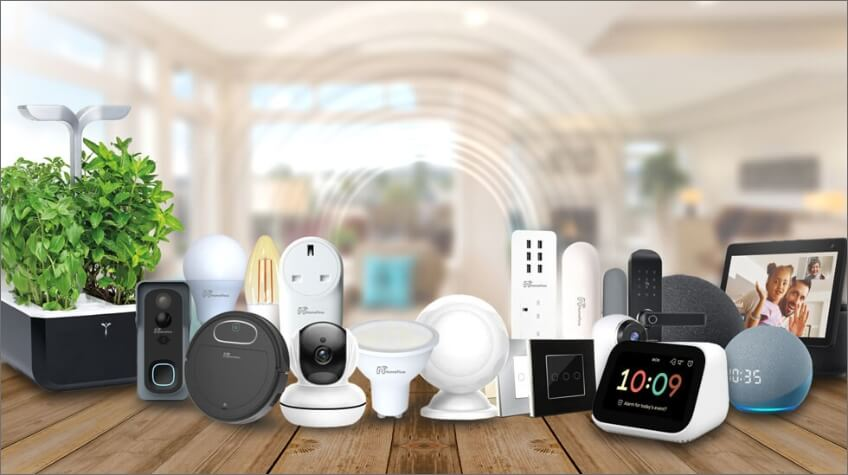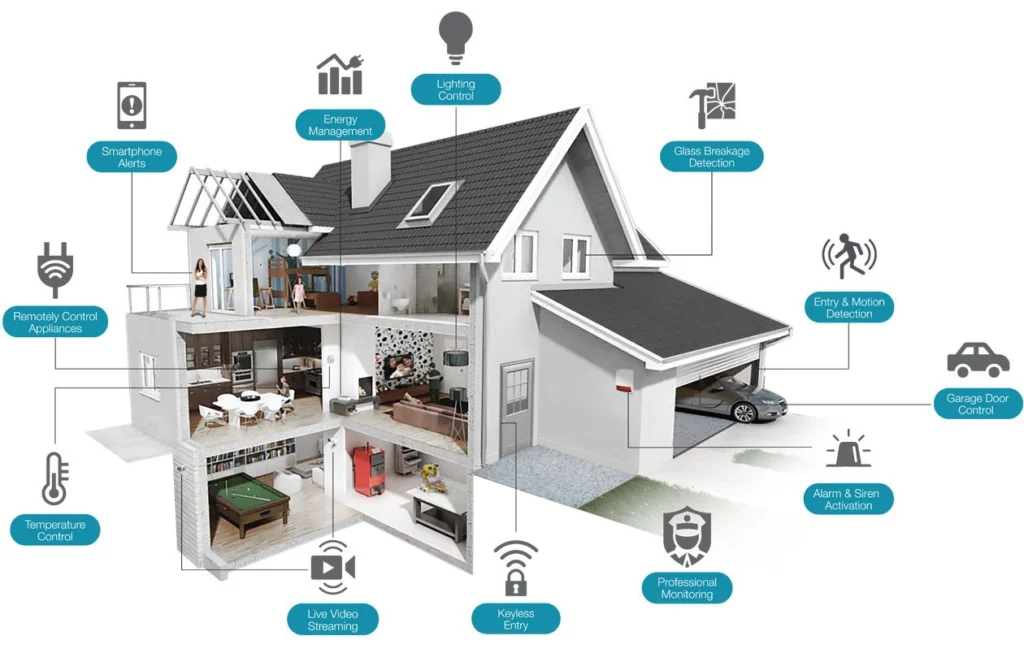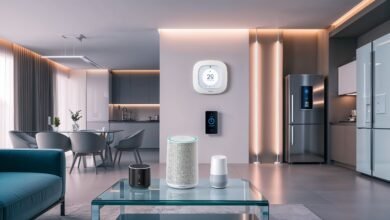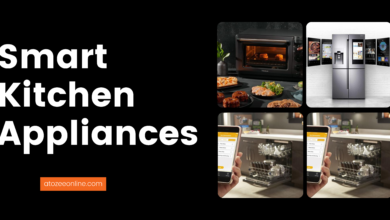What is a Smart Home

What is a Smart Home?
Learn What a Smart Home is and how it can revolutionize your daily life. Explore the benefits, technologies, and how to create your smart home efficiently.
What is a Smart Home?
A smart home is a residence equipped with interconnected devices that automate tasks and provide greater control over household functions. These devices, often controlled through a central system or mobile app, can include lighting, heating, security, and entertainment. The concept of smart homes has evolved significantly, blending convenience with advanced technology.
Historical Development
The idea of home automation dates back to the early 20th century, with the introduction of labor-saving devices like washing machines and refrigerators. However, the modern smart home began taking shape in the late 1990s and early 2000s, with the advent of the internet and wireless technology, paving the way for connected devices that communicate seamlessly.
Evolution of Smart Homes:
- Early Innovations:
Early smart home innovations focused on basic automation, such as programmable thermostats and lighting controls. These initial steps laid the groundwork for more sophisticated systems that would emerge later. - Current Trends:
Today, smart homes encompass many technologies, from voice-activated assistants to fully integrated home security systems. The trend is moving towards creating a cohesive ecosystem where all devices work harmoniously, enhancing user experience and functionality.
Core Technologies in Smart Homes:
- Internet of Things (IoT):
The Internet of Things (IoT) is the backbone of smart home technology. It enables devices to connect and communicate over the internet, allowing for remote control and automation. IoT devices range from simple sensors to complex home appliances. - Artificial Intelligence (AI):
Artificial Intelligence (AI) plays a crucial role in smart homes by learning user preferences and making intelligent decisions. AI-powered assistants like Amazon Alexa and Google Assistant can control various aspects of the house through voice commands and predictive algorithms.
Smart Home Devices:
- Smart Speakers:
Smart speakers, such as the Amazon Echo and Google Nest, are the central hub for many smart homes. They can play music, answer questions, and control other smart devices through voice commands. - Smart Lights:
Intelligent lighting systems allow users to control the intensity and color of lights through a mobile app or voice commands. They can be programmed to change based on the time of day or specific events. - Smart Thermostats:
Smart thermostats, like the Nest Learning Thermostat, help optimize energy usage by learning the household’s schedule and preferences. They can be controlled remotely and integrated with other smart devices.

How Smart Homes Work:
- Connectivity:
Smart homes rely on robust connectivity through Wi-Fi, Bluetooth, or specialized communication protocols like Zigbee and Z-Wave. This ensures that devices can communicate with each other and with the central control system. - Automation:
Automation in smart homes involves setting up routines and rules for devices to follow. For example, lights can be programmed to turn on when someone enters a room, or the thermostat can adjust automatically based on the time of day. - User Interfaces:
User interfaces for smart homes include mobile apps, web dashboards, and voice control systems. These interfaces provide a convenient way for users to monitor and manage their smart devices.
Benefits of Smart Homes:
- Convenience:
Smart homes offer unparalleled convenience by automating routine tasks. With a simple voice command or a tap on their smartphone, users can control lighting, heating, and security systems, empowering them with a new level of control over their living environment. - Security:
Enhanced security is a significant benefit of smart homes. Intelligent security systems, with features like real-time video monitoring, motion detectors, and automated alerts, provide homeowners with a sense of reassurance and peace of mind. - Energy Efficiency:
Smart homes contribute to energy efficiency by optimizing appliances and heating systems. With smart thermostats and energy monitors, users can reduce waste and lower utility bills, fostering a sense of responsibility towards the environment.
Challenges in Smart Home Adoption:
- Privacy Concerns:
Privacy is a primary concern in smart homes, as connected devices collect and transmit personal data. Ensuring robust security measures and choosing reputable brands can help mitigate these risks. - Cost:
The initial cost of setting up a smart home can be high, considering the price of devices and potential installation fees. However, the long-term savings in energy costs and the convenience offered can offset these expenses. - Interoperability Issues:
Not all smart home devices are compatible, leading to interoperability issues. Choosing devices that work well together is crucial to creating a seamless smart home ecosystem.
Popular Smart Home Platforms:
- Amazon Alexa:
Amazon Alexa is one of the leading smart home platforms, offering extensive device compatibility and powerful voice control features. It integrates with various third-party devices, making it a versatile choice for smart home enthusiasts. - Google Home:
Google Home provides robust integration with Google services and a growing list of compatible devices. Its AI-powered assistant, Google Assistant, excels in understanding natural language and offering personalized responses. - Apple Home Kit:
Apple Home Kit focuses on security and ease of use, with strict standards for device compatibility. It provides seamless integration with Apple’s ecosystem, making it an excellent choice for users already invested in Apple products.
Setting Up a Smart Home:
- Planning:
Setting up a smart home requires careful planning. Start by identifying the areas of your home where automation will provide the most benefit. Consider the devices you need and ensure they are compatible with each other. - Budgeting:
Budgeting is crucial when creating a smart home. Prices for smart devices can vary widely, so it’s essential to prioritize your needs and plan your purchases accordingly. - Installation:
Installation can range from simple plug-and-play devices to complex systems requiring professional installation. Ensure you have the necessary tools and knowledge before starting your smart home project.
Integrating Smart Home Devices:
- Compatibility:
Ensuring compatibility between smart home devices is essential for creating a seamless experience. Check for compatibility with your chosen platform and other devices before purchasing. - Ecosystem Building:
Building a smart home ecosystem involves integrating various devices to work together. This can include setting up routines, creating automation scripts, and ensuring devices can communicate effectively.
Future of Smart Homes:
- Emerging Technologies:
The future of smart homes is promising, with emerging technologies like 5G, advanced AI, and machine learning poised to revolutionize the industry. These technologies will enable faster, more reliable connections and smarter automation. - Market Predictions:
The smart home market is expected to grow significantly in the coming years. Increased demand for convenience, security, and energy efficiency will drive this growth, making smart homes more accessible and affordable.
Security in Smart Homes:
- Encryption
Encryption is vital for protecting data transmitted between smart home devices. Ensure that your devices use robust encryption standards to safeguard your personal information. - Access Control
Access control mechanisms, such as strong passwords and multi-factor authentication, are essential for securing smart home systems. To enhance security, regularly update your passwords and use authentication methods. - Vulnerability Management:
Regularly updating firmware and software is crucial for managing vulnerabilities in smart home devices. Manufacturers often release updates to address security flaws, so keeping your devices up to date is essential.

Smart Home for Seniors:
- Health Monitoring:
Smart homes can significantly benefit seniors by providing health monitoring solutions. Devices like smartwatches and medical alert systems can track vital signs and alert caregivers in emergencies. - Safety Enhancements:
Safety enhancements in smart homes for seniors include fall detection sensors, automated lighting, and remote monitoring. These features help ensure the safety and well-being of elderly residents.
Smart Home for Families:
- Parental Controls:
Parental controls in smart homes allow parents to monitor and restrict their children’s access to certain devices and content, ensuring a safe and controlled environment for children. - Entertainment Systems:
Smart home entertainment systems provide families with a rich multimedia experience. These systems can integrate streaming services, gaming consoles, and sound systems for a seamless entertainment setup.
Energy Management in Smart Homes:
- Smart Meters:
Smart meters provide real-time data on energy usage, helping homeowners identify areas where they can reduce consumption. This leads to more efficient energy use and cost savings. - Renewable Integration:
Integrating renewable energy sources like solar panels with smart home systems can enhance energy efficiency. Smart home systems can optimize the use of renewable energy, reducing reliance on traditional power sources.
Smart Home Automation:
- Scripting:
Automation scripting allows users to create custom routines for their smart home devices. These scripts can automate tasks such as turning off lights at a specific time or adjusting the thermostat based on weather conditions. - Scheduling:
Scheduling is a crucial feature of smart home automation. Users can set schedules for various devices, ensuring they operate efficiently and according to their preferences. - Voice Commands:
Voice commands provide a hands-free way to control smart home devices. Voice assistants like Amazon Alexa and Google Assistant can perform various tasks based on verbal instructions, adding convenience and ease of use.
Cost of Smart Home Implementation:
- Device Prices:
The cost of smart home devices varies widely, from affordable smart plugs to high-end security systems. Researching and comparing prices is essential to finding devices that fit your budget. - Installation Fees:
Professional installation fees can add to the overall cost of a smart home. Consider whether you can install devices or if professional help is needed for more complex systems. - Maintenance:
Regular maintenance is essential to keep smart home devices functioning optimally. This includes software updates, battery replacements, and routine checks to ensure everything works correctly.
DIY vs. Professional Installation:
- Pros and Cons:
DIY installation is cost-effective and offers greater control, but it can be time-consuming and requires technical knowledge. Professional installation ensures proper setup and integration but comes at a higher cost. - When to Choose Which:
Choose DIY installation for simpler devices and professional installation for more complex systems or when you lack the technical expertise. Assess your needs and capabilities before making a decision.
Common Smart Home Issues:
- Troubleshooting:
Common issues in smart homes include connectivity problems, device malfunctions, and software glitches. Troubleshooting steps typically involve resetting devices, checking connections, and updating firmware. - Customer Support:
Reliable customer support from manufacturers can help resolve issues quickly. Choose brands with good reputations for customer service and support.
Conclusion:
Smart homes represent the future of living, offering unparalleled convenience, security, and efficiency. By integrating advanced technologies like IoT and AI, smart homes can transform daily life, making tasks easier and more enjoyable. While there are challenges in terms of cost and privacy, the benefits far outweigh the drawbacks. As technology continues to evolve, smart homes will become even more integrated and accessible, revolutionizing how we live.
FAQs
What is a smart home?
A smart home is a residence equipped with interconnected devices that automate tasks and provide greater control over household functions through a central system or mobile app.
How does a smart home work?
Smart homes connect devices through Wi-Fi, Bluetooth, or specialized protocols, allowing them to communicate and be controlled remotely or through automation routines.
What are the benefits of a smart home?
Benefits include increased convenience, enhanced security, and improved energy efficiency. Smart homes can automate routine tasks, provide real-time security monitoring, and optimize energy usage.
Are smart homes secure?
Proper measures can secure smart homes, such as using strong passwords, enabling encryption, and regularly updating firmware. Choosing reputable brands also helps enhance security.
How much does it cost to set up a smart home?
The cost varies widely depending on the devices and installation methods chosen. Basic setups can be affordable, while more advanced systems with professional installation can be expensive.
Can I install smart home devices myself?
Yes, many smart home devices are designed for easy DIY installation. However, more complex systems may require professional installation to ensure proper setup and integration.




